Set health. For Col-R-Tel use, sets should be in good repair. Electronically and cosmetically restored sets perform best and produce a superior presentation. The Col-R-Tel converter system should work correctly and be in good physical condition.
Solid-state, black-and-white TVs. You might be able to use a solid-state set with the original, tube Col-R-Tel. But first, you'd need to test Col-R-Tel chassis connections and signals for proper function. This preparation is the only way to assure correct operation.
|
♦ WARNING. Col-R-Tel converter use requires a TV set with a power transformer. This transformer must provide electrical isolation from the AC line. Line isolation is an important safety issue. The Col-R-Tel chassis is hard wired to the TV set: Col-R-Tel wiring connects to four circuits in the TV set and chassis ground. A TV without a line transformer could place raw, 120 VAC on the Col-R-Tel chassis. This voltage poses a life-threatening hazard. |
Screen size. The Col-R-Tel wheel housing has a 12-inch, round viewing window. The top and bottom of this window are flat. Sets that work successfully with Col-R-Tel include those with small (10-inch) CRTs or large (14 to 17-inch CRTs). Col-R-Tel provides a size switch box that you can install on the TV. This box reduces picture size to that of the 12-inch window in the color wheel. For black-and-white viewing, you can increase picture size back to normal.
Picture tube type. The ideal TV set has a round, 12-inch CRT, like the 12LP4 or 12KP4. Of the two, the 12KP4 is the better choice. It has an aluminized screen and produces a brighter picture. The 12KP4 is electrically and physically equivalent to the 12LP4. You can use the 12KP4 to upgrade sets with the 12LP4 CRT. A bright screen is very important. Color filters in the Col-R-Tel wheel absorb about 90% of the picture tube's light. Col-R-Tel's fully saturated colors depend on this amount of absorption.
Go to Page: 1 2 3 Next
